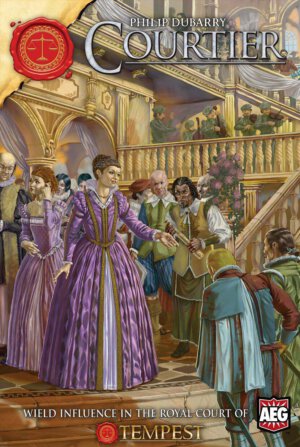Publisher: AEG
Designer: Phillip duBarry
Artists: Andrew Hepworth and Jeff Himmelman
Year: 2012
Genre: Eurostyle area control game
Players: Two to four players
Ages: 10+
Playing Time: 60 Minutes
MSRP: $34.99
Courtier is the first in the line of City State of Tempest games from AEG. If you’re not familiar with the Tempest line of games, they all take place in a shared world and even characters appear in multiple games. The games (Courtier, Dominare, Mercante, and Love Letter to date) take place chronologically so the events in one game can have an effect of the same characters in a later game. AEG has gone to great lengths to put together a developer’s kit, with a whole backstory to the setting, so would be designers have a lot at their disposal story wise and plenty to work with in creating a game for the line. The entire Tempest line is a bit of a departure for AEG as these games are much more Eurostyle in gameplay and mechanics than a majority of the titles with which the company has made a name for itself .
The components for the Courtier are excellent – which is usually the case with anything from AEG – and include the board, wooden cubes representing influence, five decks of cards (Ability, Fashion, Influence, Petition, and Power) as well as a twelve page rule book. The book is well laid out and after a read through or two everything makes sense. Also included are four variants to play including a two player game with a third “ghost” player.
The cards are broken into five decks and each has a specific purpose.
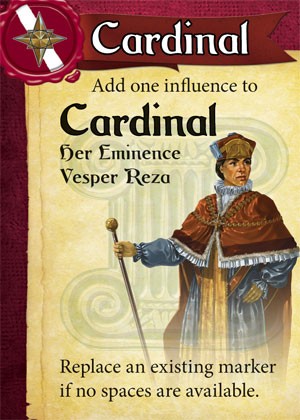
Fashion – This is a bit of a random event deck as well as the end game timer. Each time a player completes a Petition (I’ll get to that in a minute) a Fashion card is drawn and the instructions on the card are implemented. Mainly these actions are adding neutral influence to particular coteries but one of the cards reads “The Queen is Arrested” and drawing that immediately ends the game. To prevent the end game card from being drawn too early, at the start the deck is divided in two six card piles and the Arrested card is shuffled into the bottom half. This way you never know exactly when the game will end – unless the Arrested card happens to be the final Fashion card of course.
Influence – One of the two types of cards you’ll hold in your hand to play on your turn. These cards can indicate a specific person in a specific coterie in which to place influence upon when played, for example the Magistrate in the Senate would receive one of your influence markers if you play that card; some indicate a specific coterie in which influence can be placed, another example would be a card indicating placing one influence on either member of the Senate if played; finally there are wild cards which allow you to place influence on anyone anywhere on the board.
Petition – This is the main way in which you’ll score your victory points and to do so each petition shows between two to four persons you need to control in order to complete the petition. Of course higher value petitions require the control of more people and/or those who require more influence cubes to control.
Power – The second type of card which you’ll have in your hand. The Power cards have a wide range of abilities such as placing influence, gaining influence, moving influence, on the board, gaining extra cards, and so forth. These cards can add a great deal of chaos to the proceedings and you can easily boost your chances of winning (or deflating another player’s chances) by playing a few of these smartly.
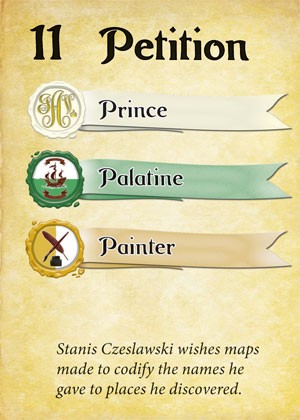
You’ll begin by shuffling the different card decks and placing them in their respective piles. You then reveal four petition cards, and one each of the power and influence cards. Each player begins the game with 15 influence markers in their pool, one hidden secret petition which has been dealt to them, and a hand of five cards.
To get their starting hands the players can carry out a quick auction. At first, I was a little put off when I heard that there was bidding at the start – I’m not a huge fan of auction mechanics – but after I saw how quick and painless it was I didn’t mind it at all. The rules also recommend doing away with the auction for your first couple of games – a good idea since most people wouldn’t know what a good hand looks like until they’ve played Courtier – and just deal each player a hand of three Influence and two Power cards. If you do choose the auction method, each player decides on a five card mix of influence/power cards. These cards are drawn from their decks and laid out on the table. Then, players bid on the hands with their influence cubes. If you win the bid for a particular hand, you lose your bid cubes to your reserve. If you get outbid, the cubes go back to your pool. So, bidding big could hurt you by giving you less influence cubes at the start. Either process works well in my experience plus this auction doesn’t go on forever as you’ll only bid on the same number of hands as there are players.
Game play is simple as you just carry out one of three actions during your turn: play a power or influence card from your hand and do what the card text instructs you to do, discard any/all of the cards in your hand, or take one influence marker from your reserve and put it in your pool.
After you take your one action you then have the option to complete a petition card then you always refill your hand back to five cards by drawing from either the influence or power decks.
The text on the power and influence cards let you know what you can do with that card such as placing influence markers on certain characters (or within a particular coterie), have you move influence markers around the board, draw or discard cards, or even gain influence markers from your reserve. Not a whole lot of mental heavy lifting but a lot of times you’ll have plenty of different options based on the cards in hand so you may see a bit of analysis paralysis in your first few games as the players begin to concoct various strategies. If you place influence on a character which is already filled you can replace another color influence with your own.
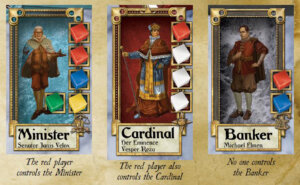
Once you’ve completed your single action you check to see if you can complete any of the visible Petition cards or the one Petition you had dealt to you at the start of the game. The Petition cards show two to four characters and if you control all of them you gain that Petition and score the victory points indicated on the card. Obviously the higher valued Petitions have more characters and/or characters which require more influence to control. If you’re able to complete a Petition, you’ll score the points, take the card, replace it with a new Petition from the deck, and then draw a Fashion card. These Fashion cards have some flavor text as to goings on in court but the main game related mechanic of the card is to produce neutral influence. This is interesting because on one hand it helps to speed up game play as it would take forever for the players to dole out influence without it and the pace of the game ramps up as it becomes easier and easier to control characters, as Fashion cards are played, because neutral influence counts as your own influence during your turn. When it’s the next player’s turn the neutral influence counts as theirs and so on. If the Fashion card drawn is “The Queen is Arrested” then the game immediately ends and whoever has the most victory points is the winner.
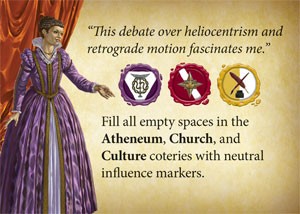
I think I’d classify Courtier as a borderline gateway game. There really isn’t anything in place mechanically which would throw a new gamer for a loop but there might be just a tad more a player needs to keep an eye on (gaining that coterie control card, scoring Petitions, when to play a card most effectively) than a very casual gamer may be used to. This certainly is no knock against the game but just an observation. I have to say I’ve only played with four players and everyone has had a good time! The two player variant is included but taking a look at it I don’t have the impression it would be as fun as the full compliment of four gamers as it appears the two players have to combine to play the role of the ghost player.
All in all Courtier is an excellent game and one of the best I’ve played released in 2012! At a MSRP of $34.99 it’s practically a steal so if you don’t already have the title in your collection you owe it to yourself to run out there and grab a copy!



